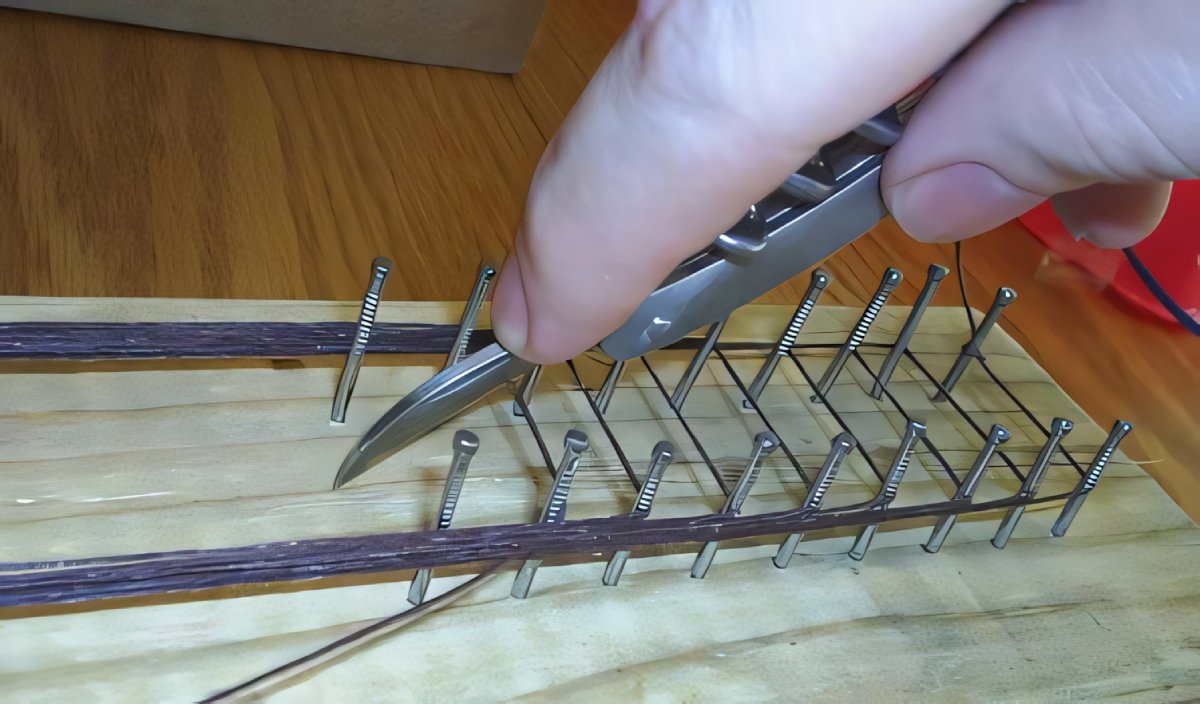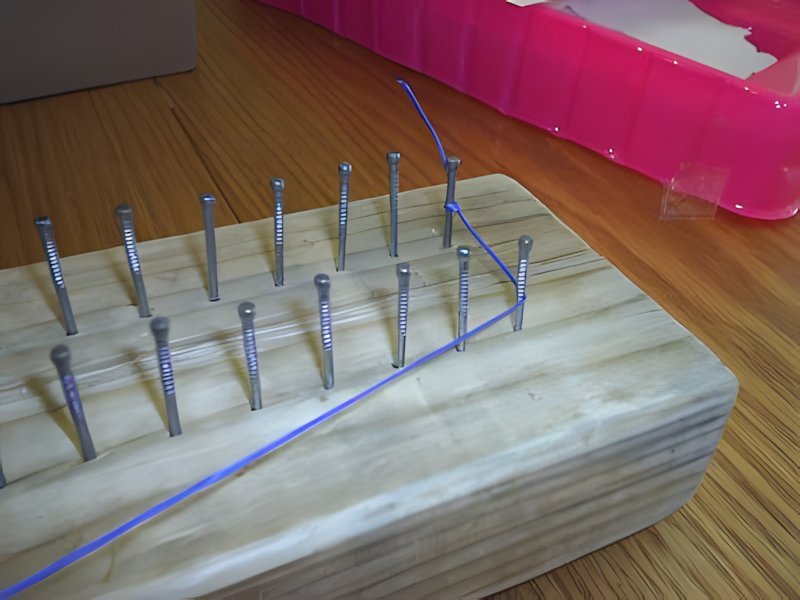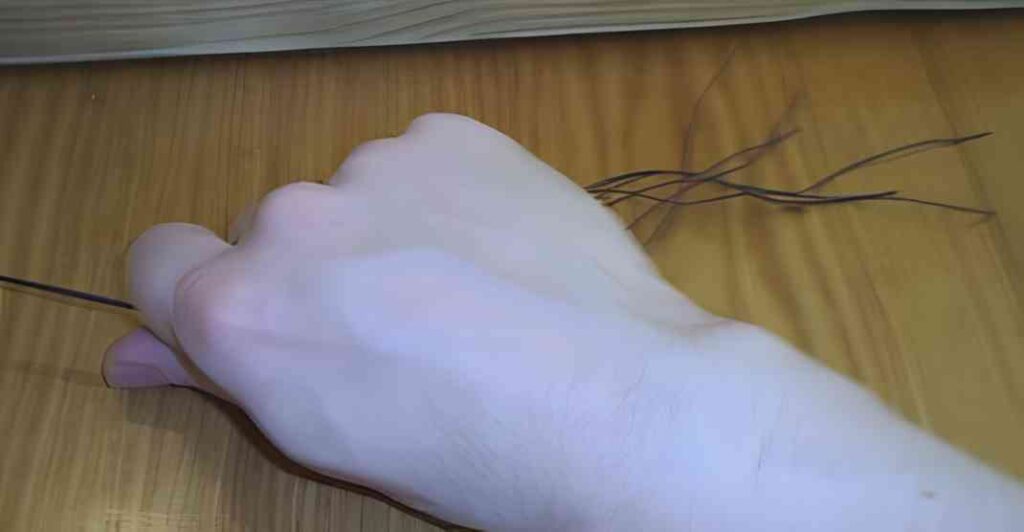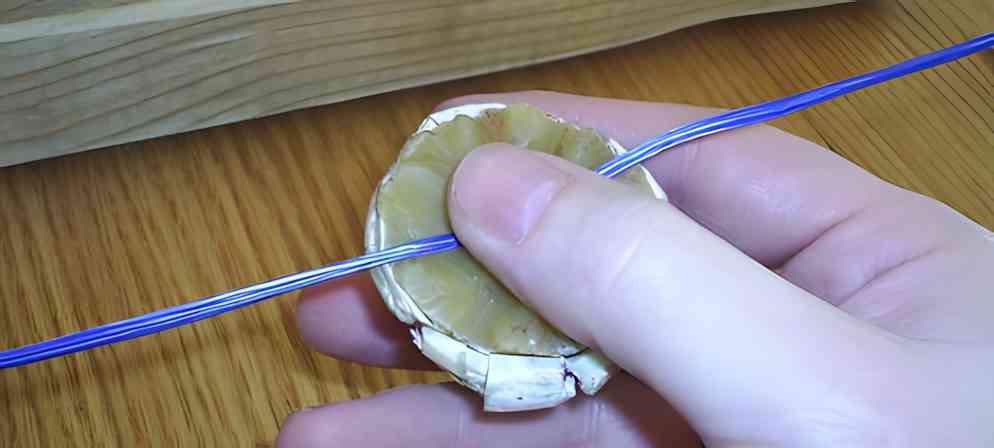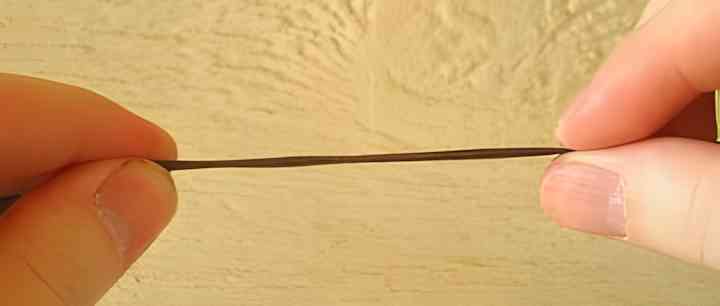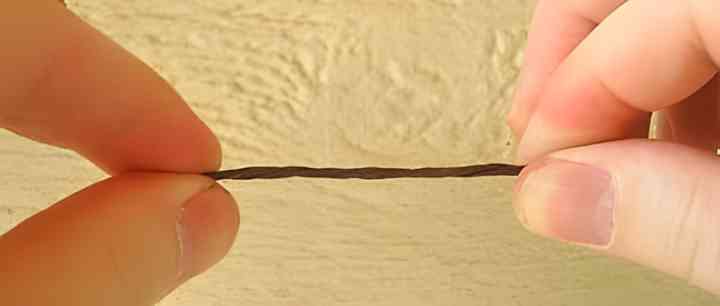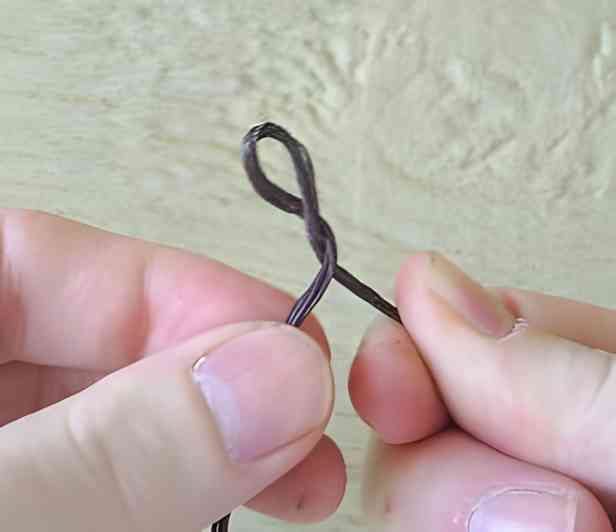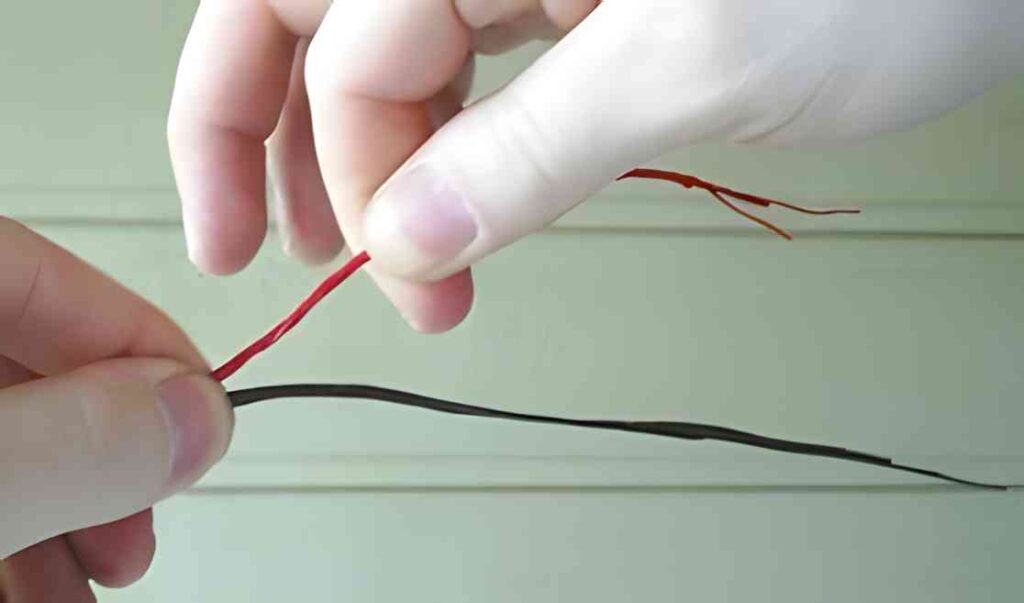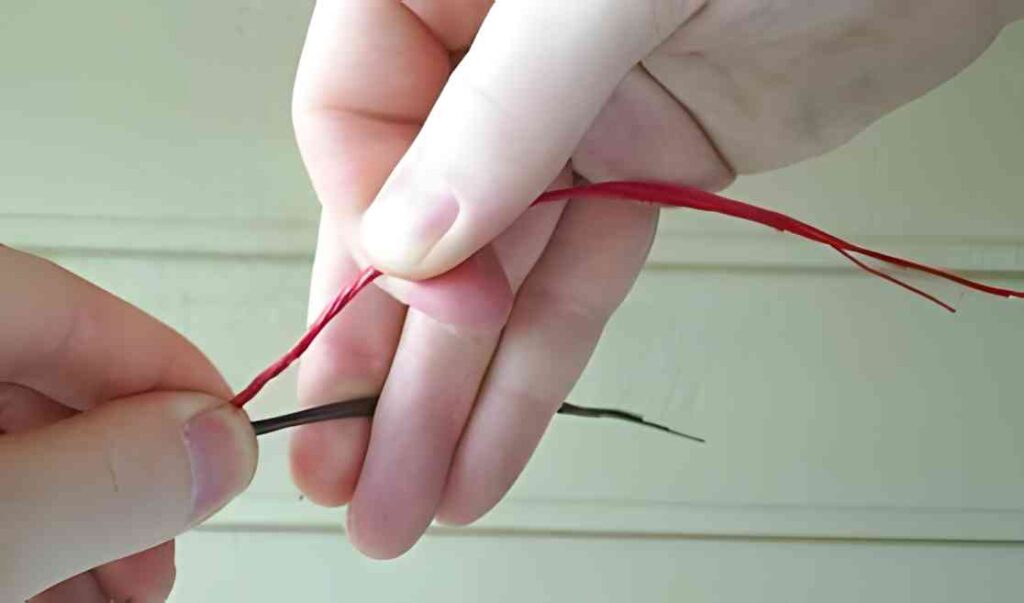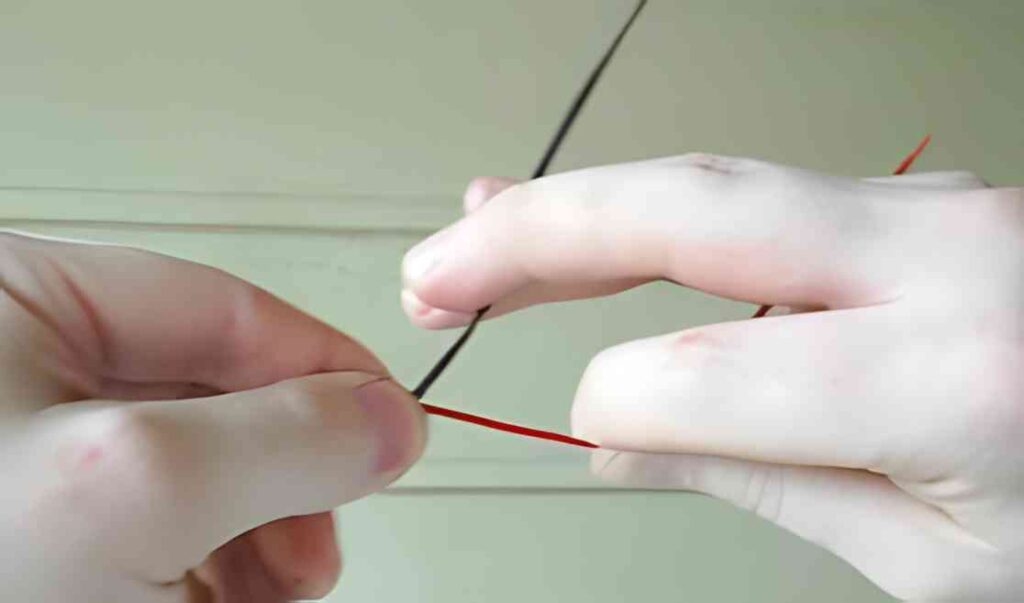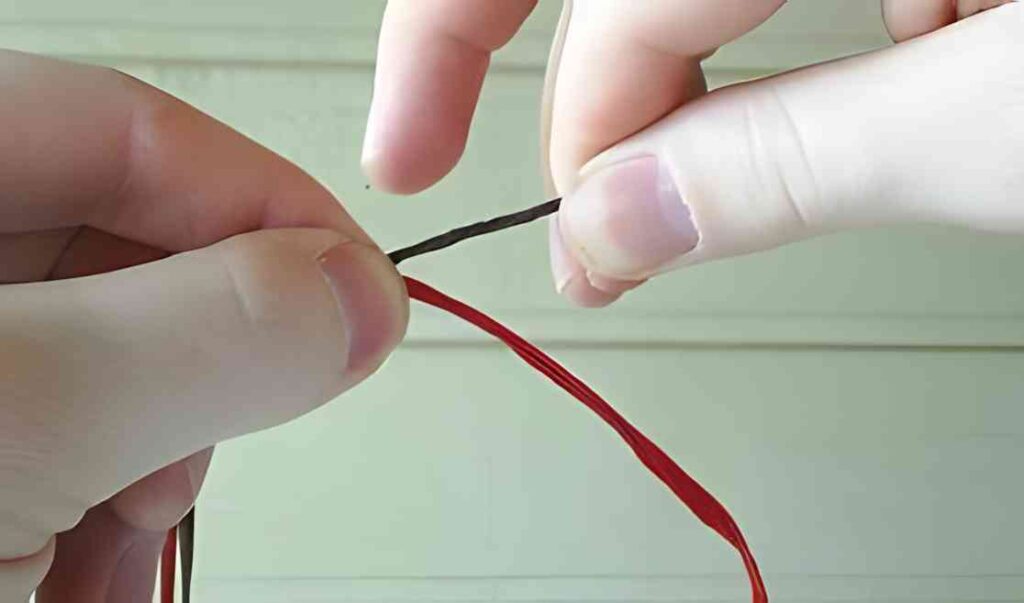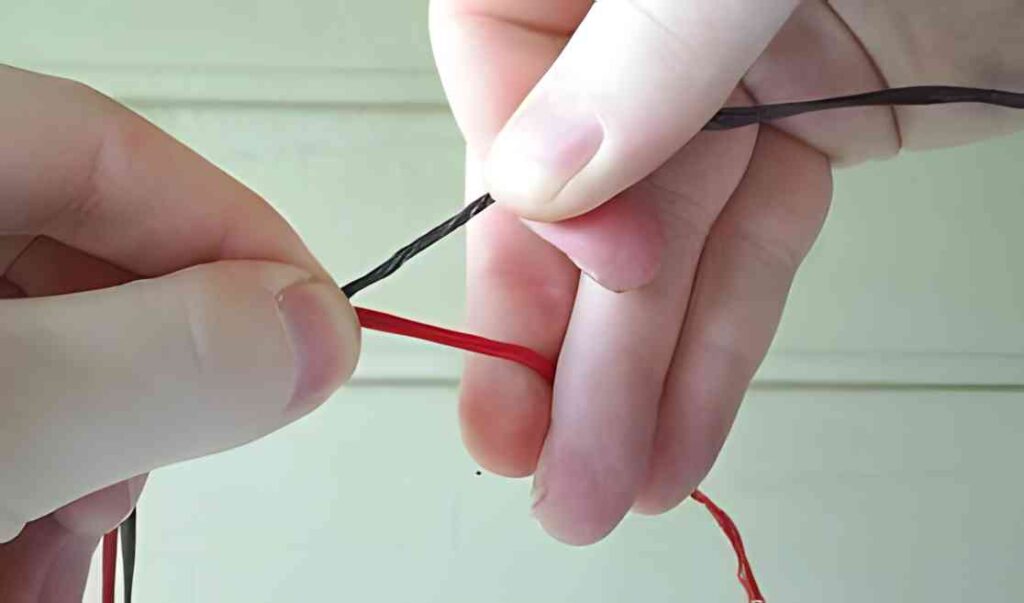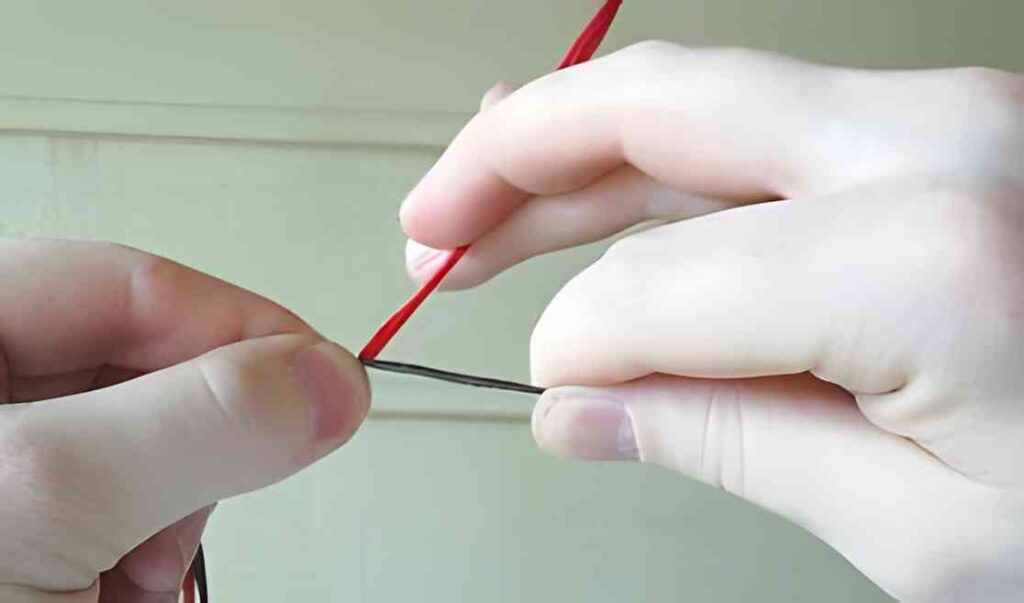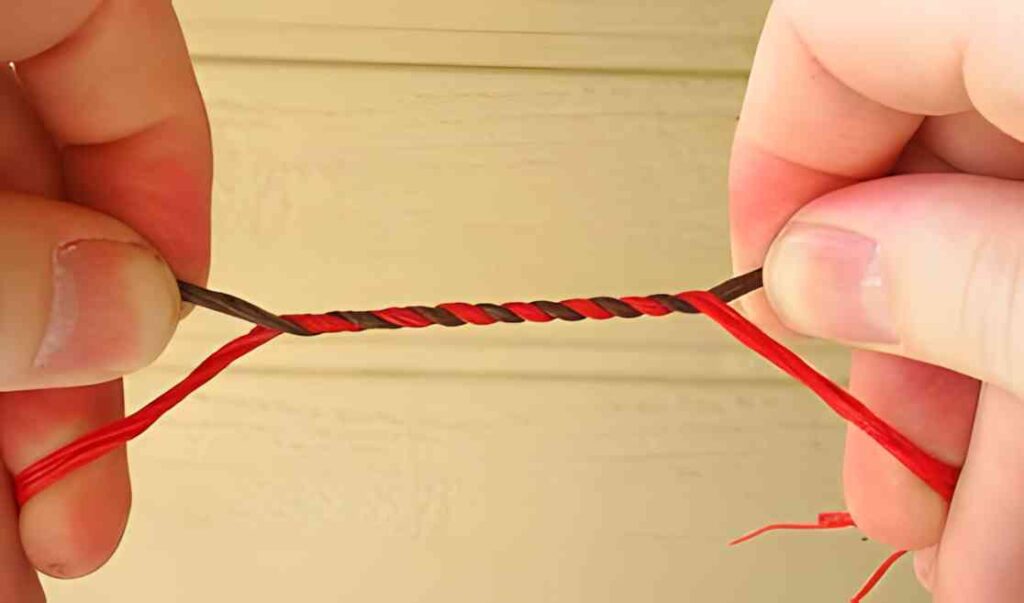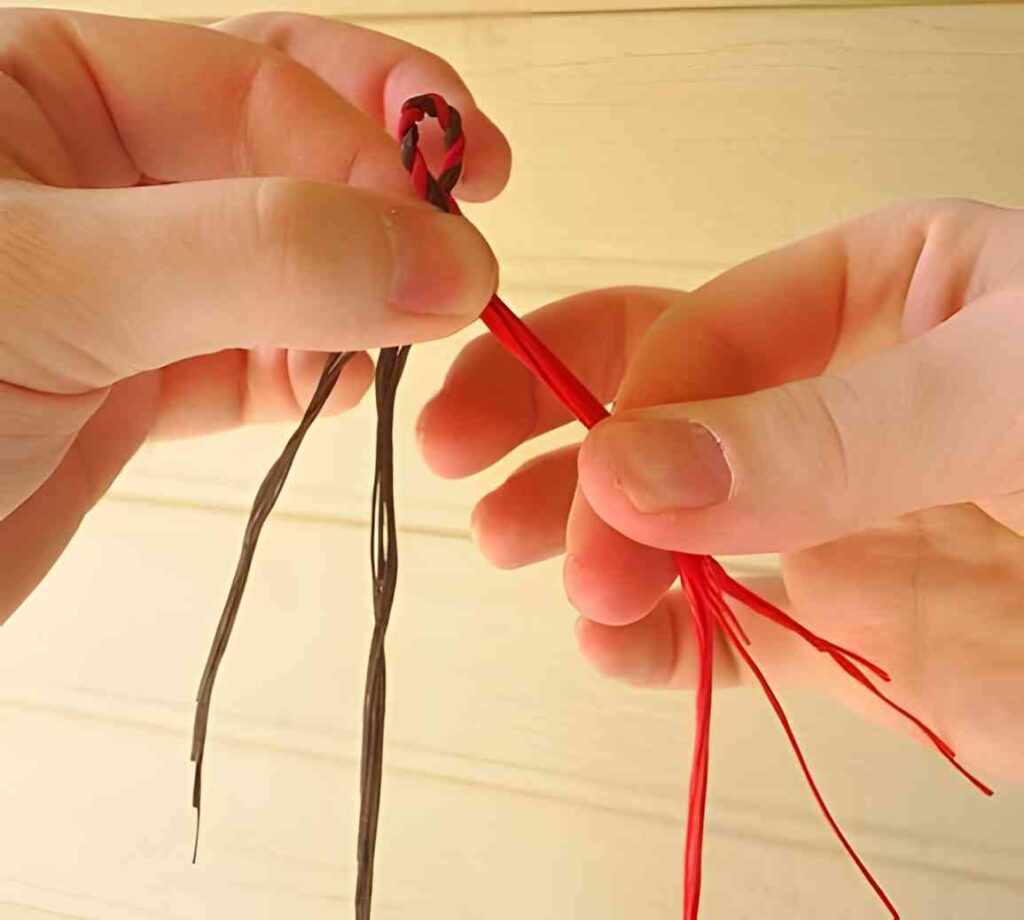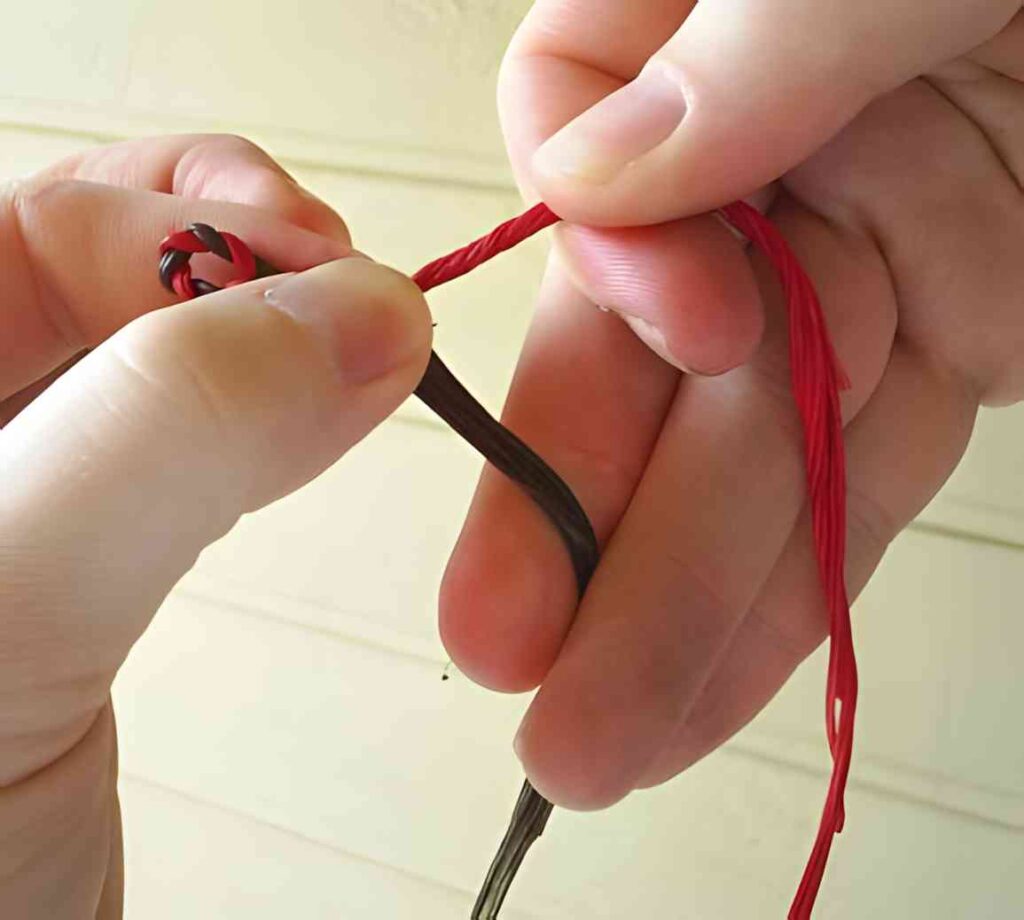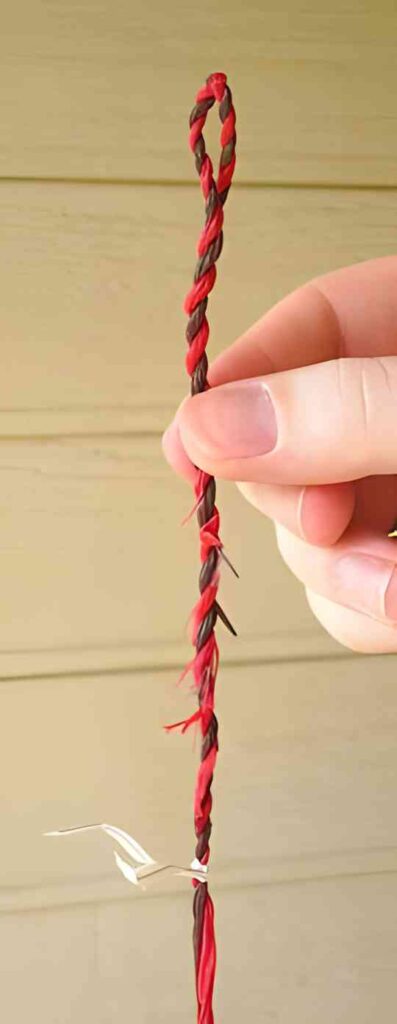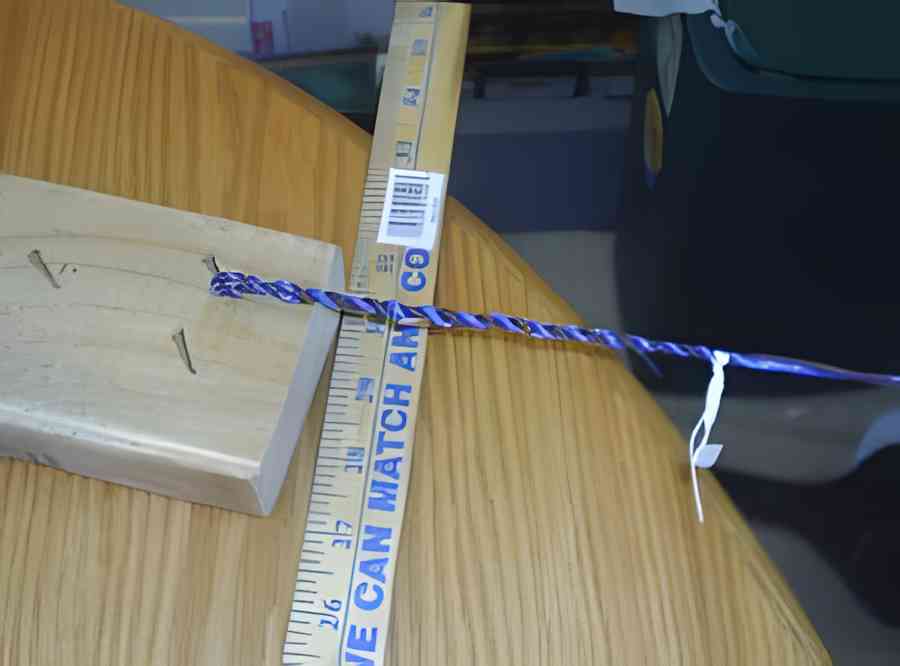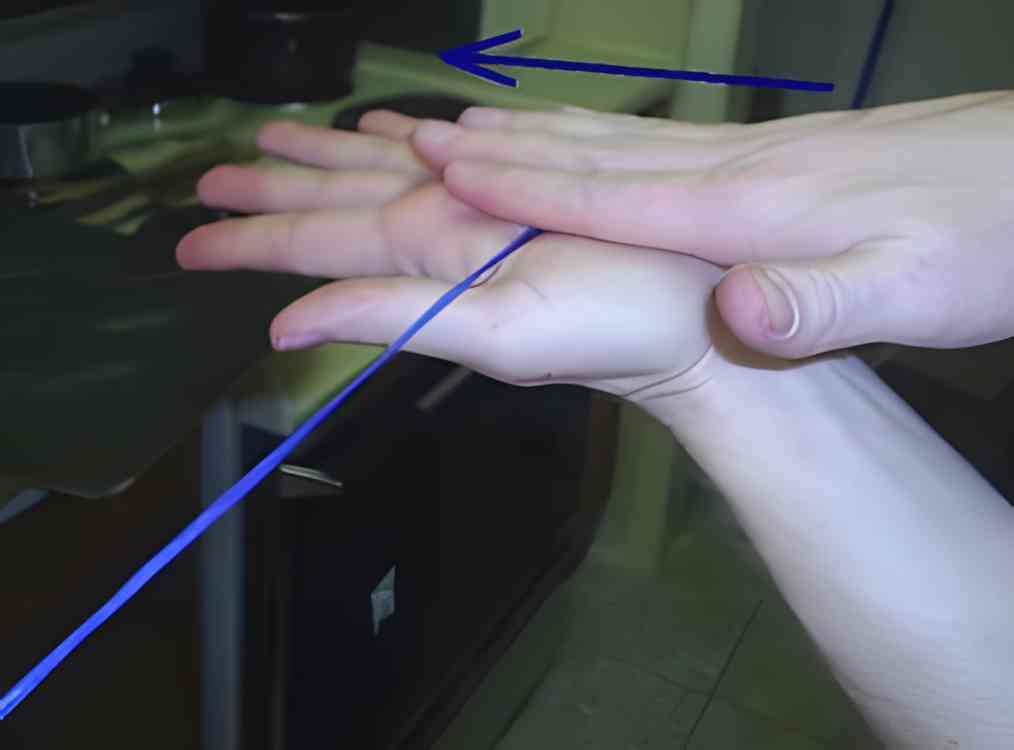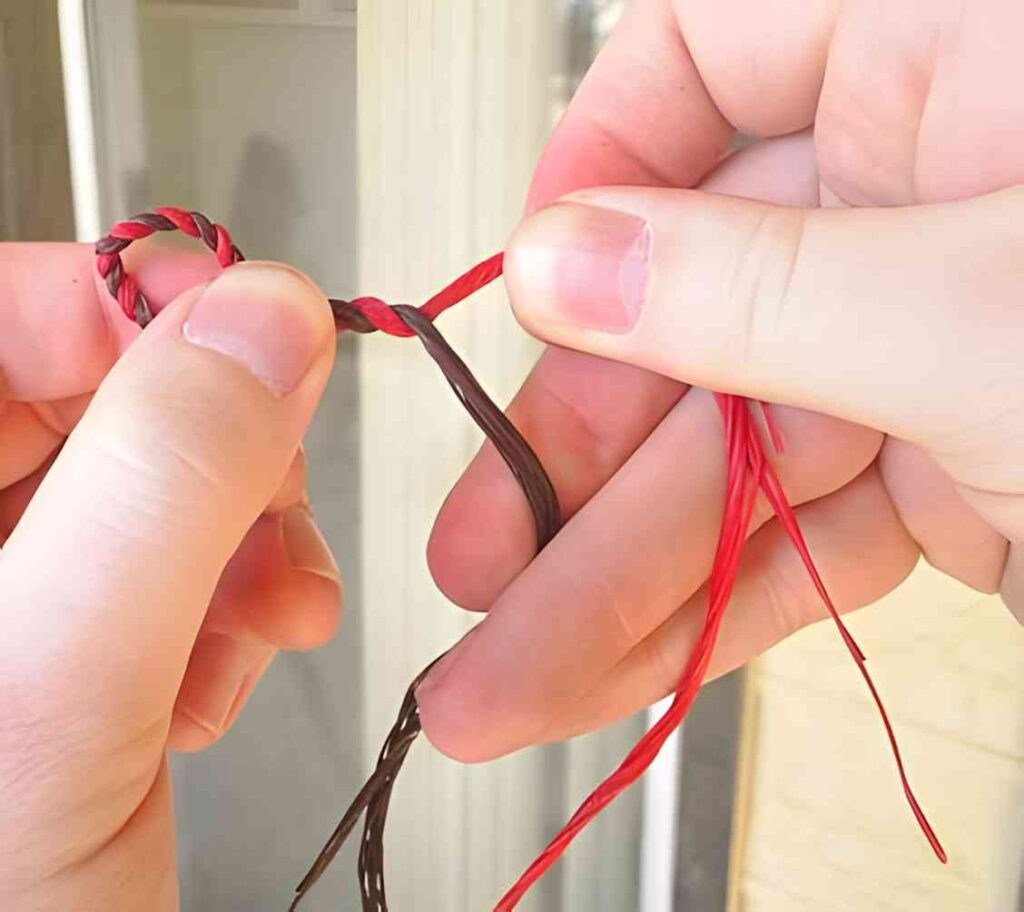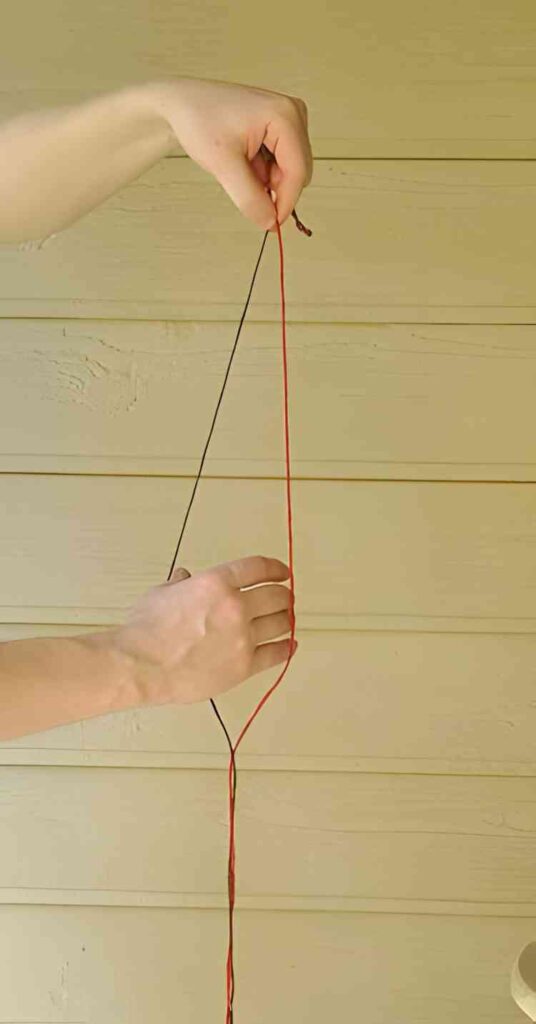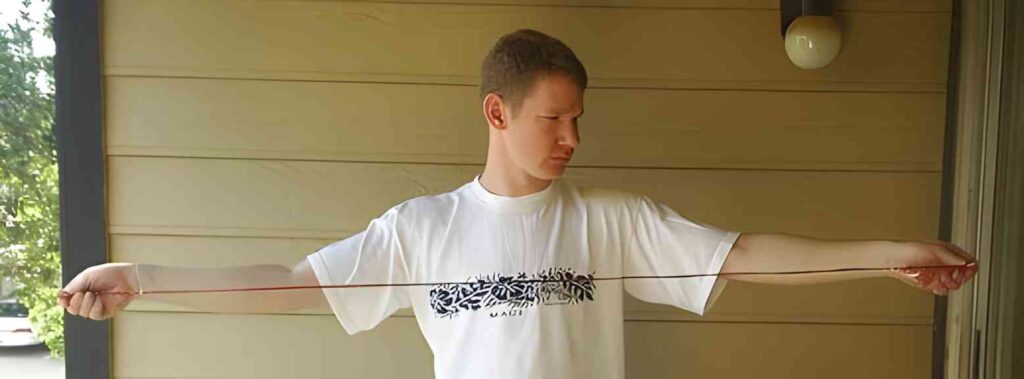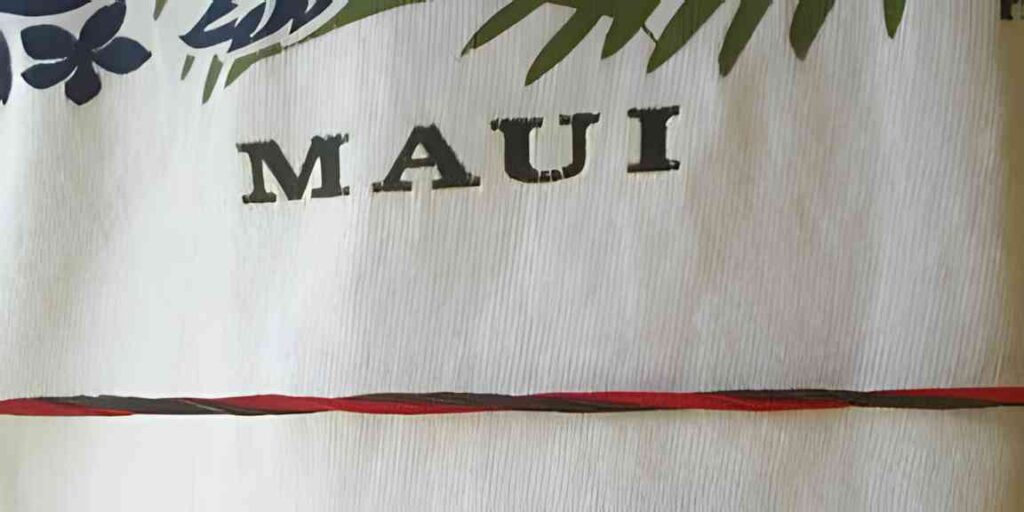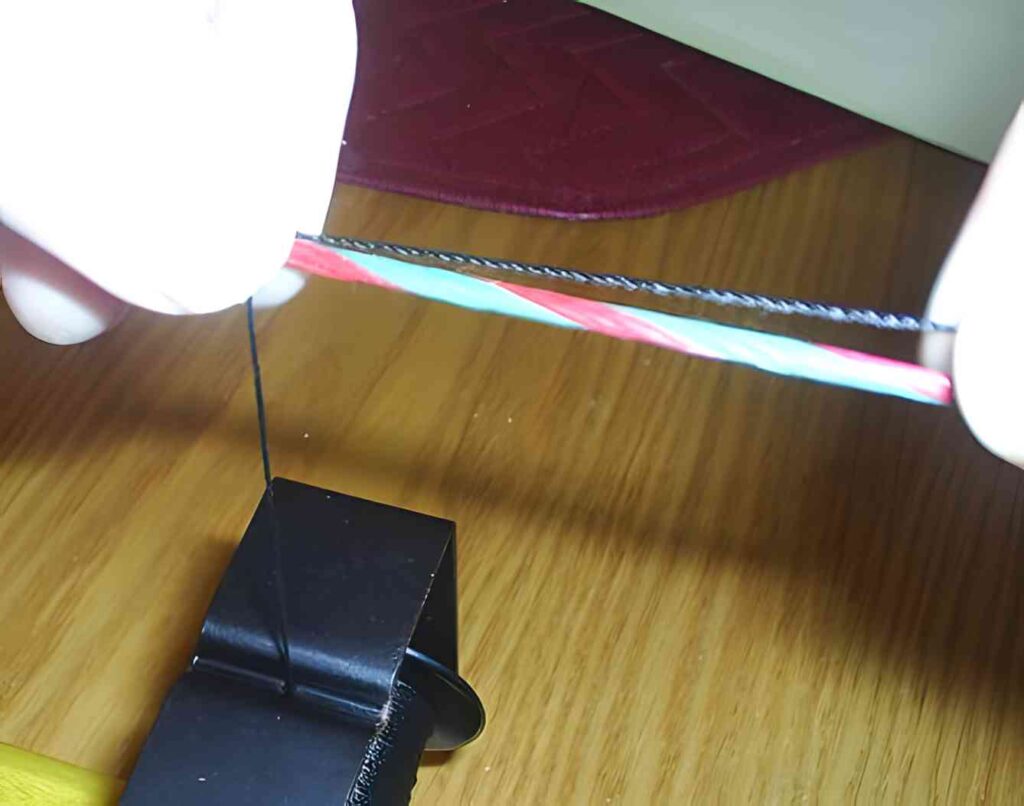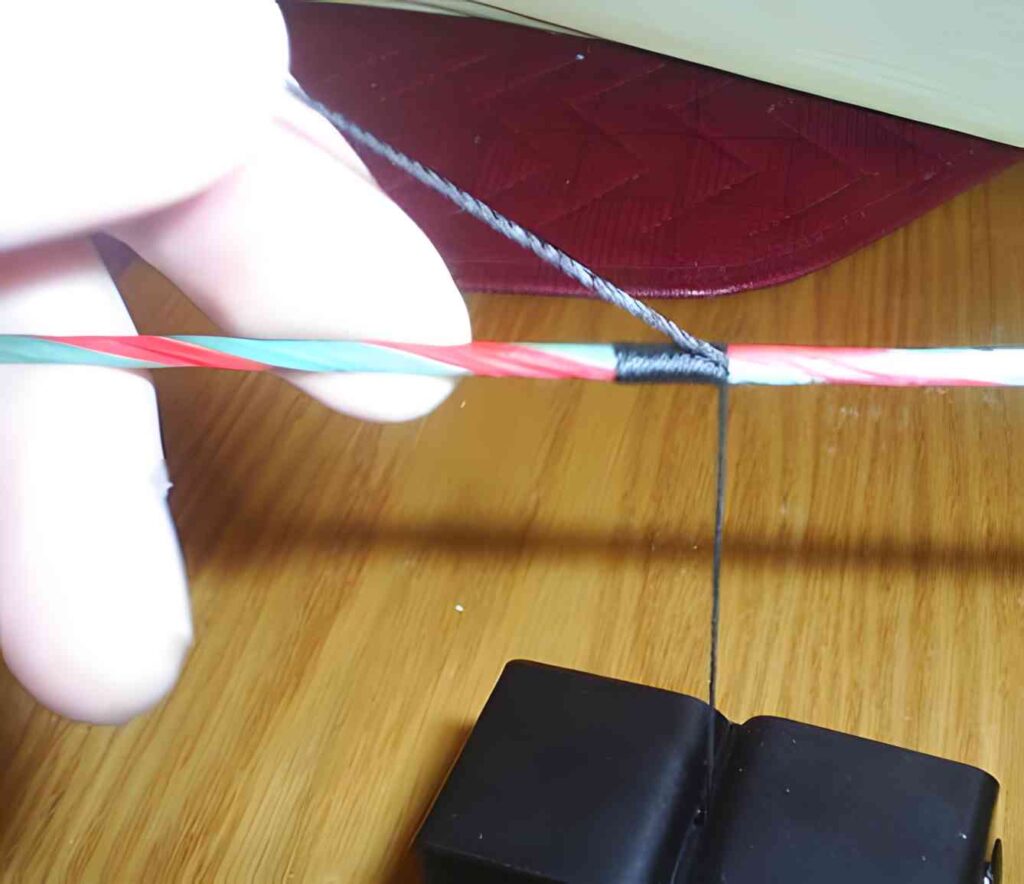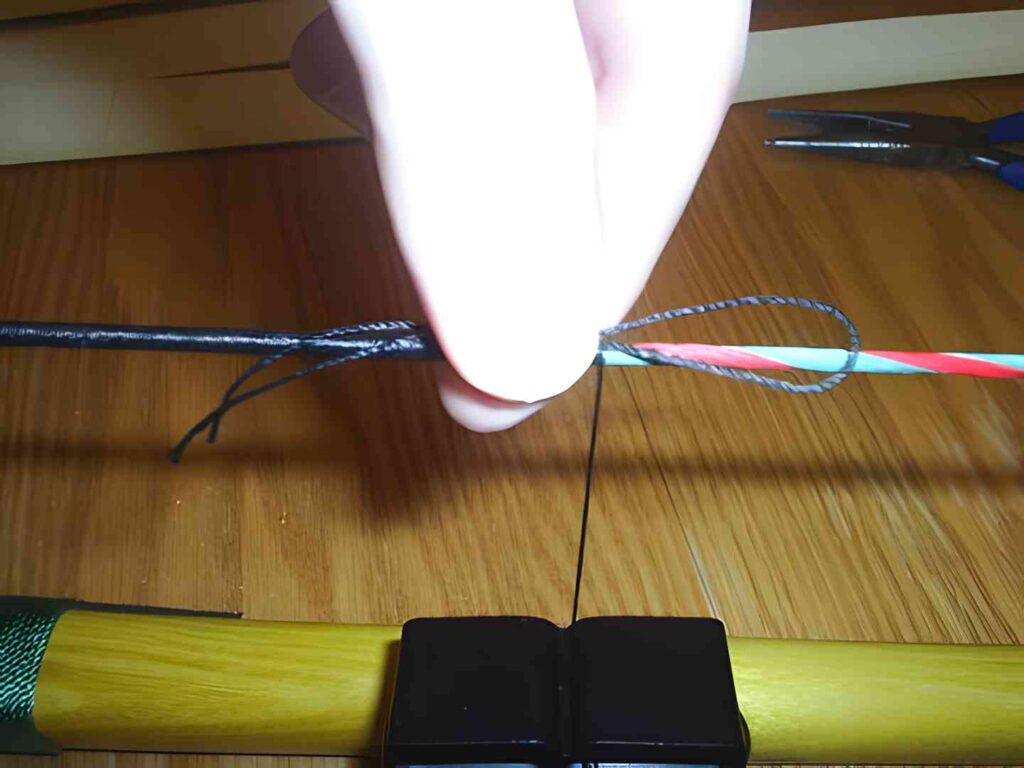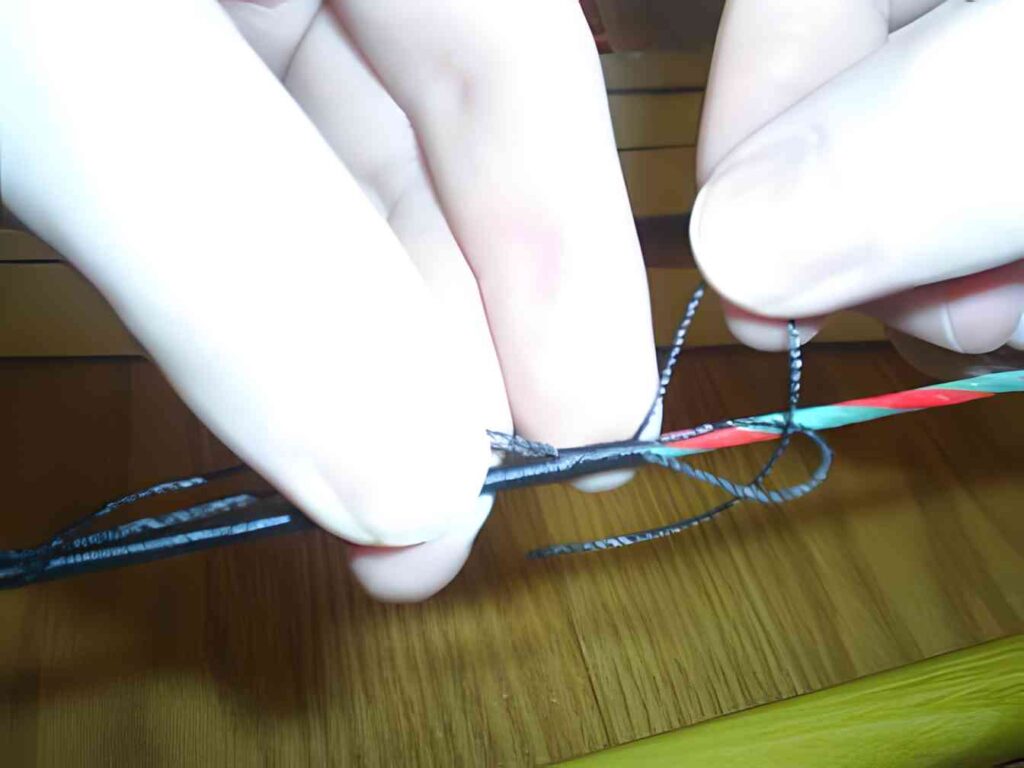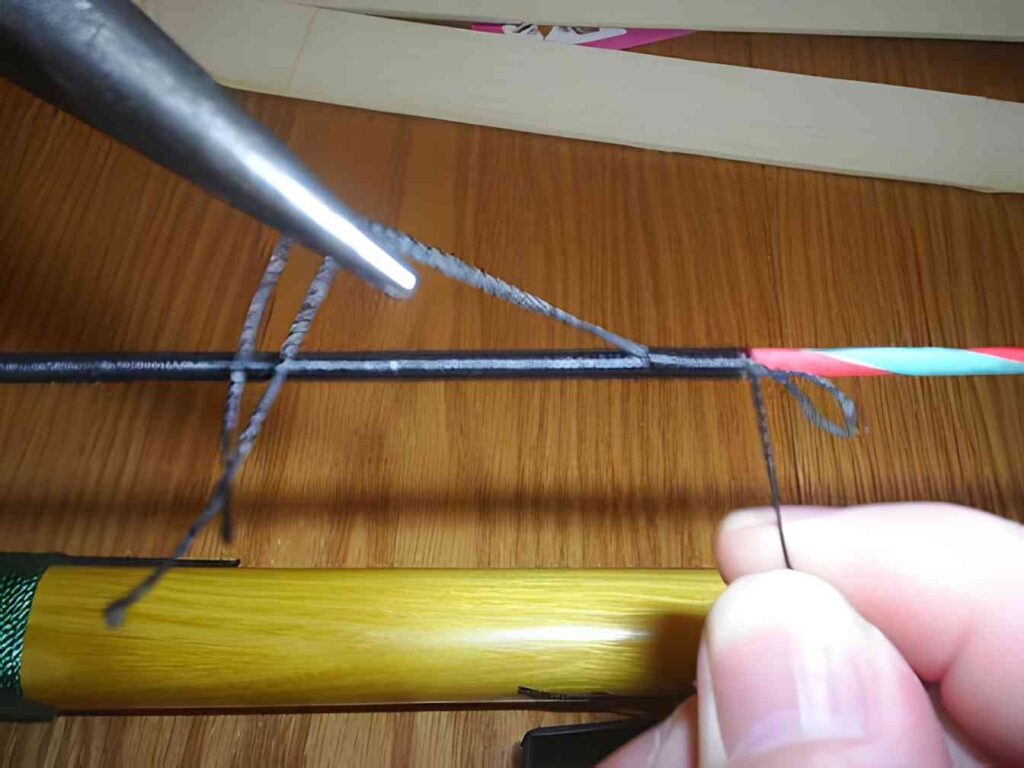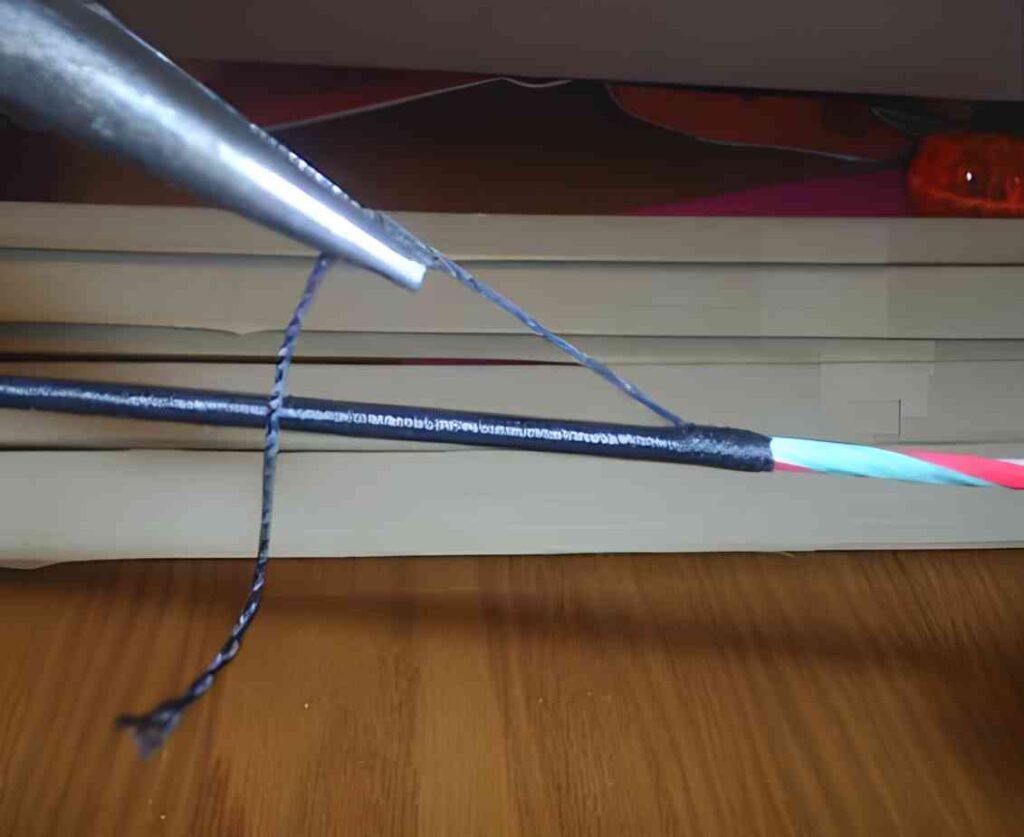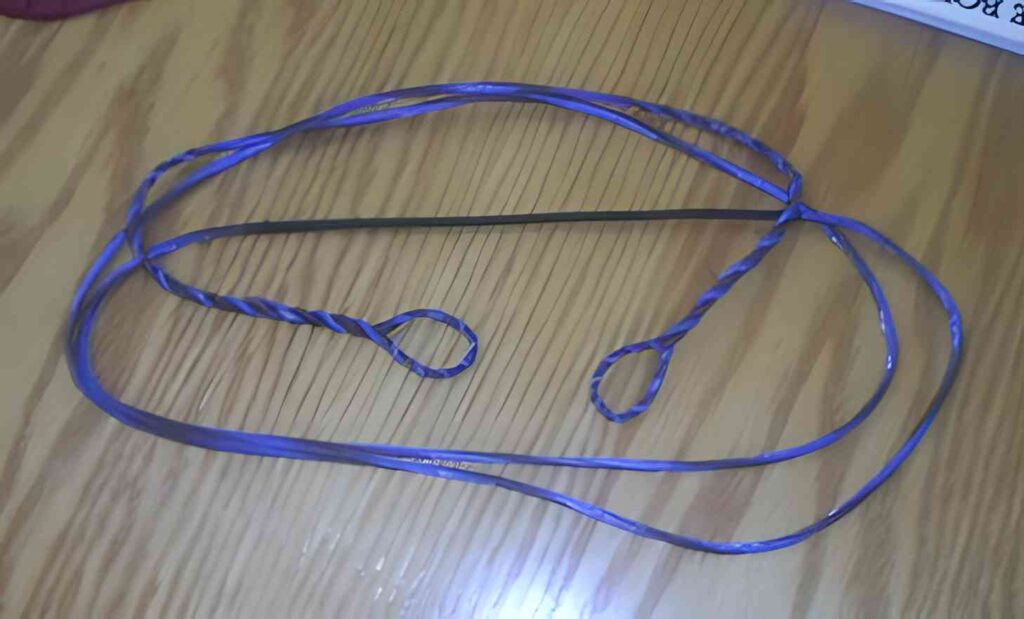Special Thanks to Sam Harper for allowing us to republish his tutorials and build along instructions. His expertise and knowledge in the bow-making field have greatly benefited many readers, and we are grateful for his generous permission.
I remember it took me a long time to make my first flemish string. I couldn’t find a how-to site that made it perfectly clear to me, and I read several of them. Finally, I just decided to do it.
By doing it, a lot of my uncertainties got straightened out. So I recommend just doing it. Even if you aren’t sure what you’re doing, just do it. It’s not like it costs a lot if you mess up.
The first time you do it, a lot of things will become more clear. By the second time, you’ll have it down pat.
In case you begin to wonder why it seems like the string I’m making in this build-along keeps changing color, it’s because I’ve done a few revisions to this build-along, and I used different strings to do them.
Making a String Jig
The first step is making a string jig. The string jig is not necessary. A lot of people make fine strings without them. But I think it’s easier to use one if you’re new. The purpose of the string jig is to get the strands all measured right.
All you need is a piece of wood, some finishing nails, a hammer, and a yard stick or tape measure. I used a 2×4 I picked up out of a dump at a construction site.
You’ll hear me mention “construction site dump” a lot on this web page, because that’s where I get a lot of my wood for making things like string jigs, bow forms, footed riser jigs, lam grinders, and cat trees.
There’s just no sense in spending money on wood when you can get it for free.
Anyway, I got a 2×4 and cut it to 30″ long. I got a box of 1-1/2″ finishing nails. If you’re a garage sailor, you should keep your eyes open for these things, but keep in mind that you could spend a lot more money in gas looking for nails at a garage sale than if you just bought a new box at Home Depot.
Here are the measurements I used.

All those red dots are finishing nails. I nailed them in to where they stick up about 3/4″. On the right side of the jig, there are 18 nails–9 on each side. The nails in the middle that I have labled 48, 50, 52, … , don’t have to be nails.
A lot of people drill holes in the wood and use a wooden peg. You can move the wooden peg to whatever hole you want depending on the string you’re making. I used nails because at the time, I didn’t have a drill.
In the picture above, the nails only go up to 60″, but in real life, my jig goes up to 72″. Now I’m going to tell you something very important, and I want you to pay attention. This is important.
That 48, 50, 52, or whatever does not represent string length; it represents bow length. If you tell yourself, “Self, let’s use the 64 inch slot soes we can make a 64 inch string,” your string will come out way too short.
The bow length should be measured from nock to nock along the back of the bow. If your bow length is 66″, then you need to use the 66″ slot on the string jig. Be sure to actually lable your string jig.
Recommended Content:
Using a String Jig
Set the jig in front of you with the 16 nails to your right. Tie a strand on one of the nails like this picture.
Wrap the string around the nails like I have in this picture.
I’m doing this one 70″, because I’m going to do a board bow build along, and that bow will be 70″ nock to nock.
Now there’s something you should know. The number of wraps depends on how strong your bow is. It might also depend on what you’re making your string out of.
I’m using B50 Dacron (which you can get at archery supply stores like Three Rivers Archery). I’ve read several different sources on the internet, and they all say something a little different, so use your own judgment. Here’s the recommendations from this web page.
20-30# | 8 strands
25-35# | 10 strands
35-45# | 12 strands
45-55# | 14 strands
55-80# | 16 strands
If you pull more than 80#, you need to cut down on the steroids.
If you’re going to make a two-ply string (which is what I’m doing), and you want to use 14 strands (which is what I’m doing), then wrap that stuff around the jig seven times.
If you’re going to do a three-ply string, and you want to do 15 strands, then wrap it around five times. You see, 5 x 3 = 15, and 7 x 2 = 14.
The next step is to cut the string. Use a razor blade, a sharp knife, or a wine bottle opener (which is what I’m using).
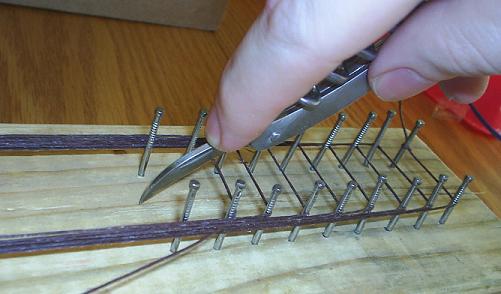
I know what you’re thinking. You’re thinking, “Wait a minute! Wasn’t that string just blue? How did it turn brown?” Well, you see, I took a picture of me cutting the blue string, but it came out blurry, so I did another with the brown string.
You’ll notice that you now have bundles where the length of the ends are staggared. That’s the whole purpose of having those nails a half inch away from each other. By staggering the lengths, your flemish loops will be more smooth. You’ll see what I’m talking about later.
Before taking the bundle off the jig, grab one end and slide your hand down to the end. That way, it’ll all hold together.
This only works if the strands are waxed. If you buy your string from Three Rivers Archery, it will already be waxed. If not, you need to wax it as you smooth it.
Once you get one end smoothed, then grab it again, and smooth it as you take it off the jig until you have smoothed it all the way to the other end.
Then wax about 18 inches on both ends, whether you got it from Three Rivers Archery or not. You don’t have to measure the 18″. Just use your eyeball. To wax it, I just hold the string between my thumb and the wax, and slide the string through. I do that on two sides.
Lay that bundle somewhere the cats won’t get it, and do the exact same thing with a different colour. I’m doing blue and brown, because those are the colours on the bow I’m going to make for my board bow build-along. Don’t feel like you have to be colour coordinated, though.
Twisting the String
This is the hard part to explain, and I’m going to do the best I can. If this doesn’t help you, then just go to google and search for other web pages about making flemish strings.
After reading a few of them, surely somebody will explain it in a way that’s clear to you. If not, then just take my advice I gave on page one and just do it.
The first thing I want to explain is this really cool property that fibers have that makes them want to become string or rope and hold together. Let’s say you’ve got a bundle of strands that you’re holding between your fingers.
With your right hand, you begin to twist the bundle away from you between your fingers.
The tighter you twist, the more the bundle will want to form a kink. Let’s say you let it. Just move your hands toward each other, making the twisted bundle a little slack, and look what happens.
Do you see that? The bundle will naturally start twisting around itself. Look careful at the directly it’s twisting, though. Notice that it’s twisting in the opposite direction from the direction you twisted it.
That’s important. The moral of the story is that if you are going to make a two-bundle string, you should twist the individual bundles in one direction. Then you should twist the bundles together in the opposite direction.
If you twist the individual bundles clockwise, then the bundles should be twisted together counter-clockwise. By twisting the individual bundles, the two bundles will want to twist against each other. That’s what holds the string together. Isn’t that wonderful?
Okay, with that wonderful news, let’s start twisting the string. The first thing you have to do is put the two bundles together and measure about 7″ from the end.
7″ is just a guideline. Every string jig is a little different. If your string turns out to be too long, then try 7-1/4″ next time.
This jig is designed for a longbow. Longbow strings are usually 3″ shorter than the bow length, whereas on recurves, it’s more like 4″ shorter than the bow length.
So if you’re making the string for a recurve, use 7-1/2″ instead of 7″. After making a few strings, you’ll get a feel for where to measure it.
read.. Making a red oak board bow
Now here’s how I do my twisting. I hold both bundles in my left hand and twist with my right. Each time I do a twist, I inch my left hand up a little. Here’s some pictures showing the procedure I use.
In this first, picture, I’m twisting the red bundle between the fingers on my right hand. The direction of my twist is away from me.
If you were standing to my right looking toward the string, I would be twisting clockwise.
In this next picture, I have twisted my hand over and grabbed the brown bundle with my other two fingers.
Then, I hold both bundles and twist my hand back so that the red bundle goes over and toward me. The brown bundle goes under and away from me.
If you were standing to my right looking toward the string, I would be twisting the red and brown bundles together in a counter-clockwise direction.
When I twist the bundles together like that, I try to hold them both and apply the same tension to both. That way, they’ll twist evently. I don’t want one bundle to be straight while the other is wrapped around it. I want them both to be even.
Starting with this next picture, I’m doing the same thing. I’m twisting the brown bundle just as I originally twisted the red bundle.
And now I’m doing the same thing as before…
…and blah blah blah.
It all makes sense now, doesn’t it? If not, just look carefully at my hands, and you should be able to tell the direction I’m twisting.
Continue doing this until you’ve got a little length twisted together.
Then fold it in half to see how big the loop will be. Twist a little more if you need to, or untwist a little until you get the loop to the size you want.
Once you get the loop to the size you want, then put the red strand with the red and the brown with the brown and smooth them into each other by squeezing it between your fingers, and sliding your fingers down..
This works better if you have lots of wax, which is why I had you wax the 18″ earlier, but you can add some wax at this point, too, if you want.
Hold the loop in your left hand, and twist with your right hand exactly as you did before, in the same direction and everything.
Twist until you get all the loose ends twisted, and then twist for another half inch or so. Then put a twisty tie on there to keep it from unraveling while you work on the other end.
Before doing the other end, there’s something you should be aware of. While you’re twisting with your right hand, everything on the other side of your hand gets twisted in the opposite direction.
Unless you undo that twist, the string will have a hard time staying together. So here’s what you do. First, put the loop you just made on a nail (I use one of the nails on my jig).
Stretch one strand out, and twist from the end. The twist would be clockwise if you are standing at the end facing the loop on the nail. I do it by rolling it in my hands, because it’s quicker. The top hand goes in the direction shown.
When you do the other loop, the same thing is going to happen, so it isn’t enough to merely get all the counter-twist out. You have to add extra twist to it. Doing so will help the string stay together in the end.
read.. Fiberglass Laminated Bow DIY Tutorial
Do the same thing to the other bundle.
At this point, you have a decision to make. You can either make another flemish loop on the other end, or you can use a timber hitch on the other end. There are some advantages to using a timber hitch.
1. If you do another flemish loop, you run the risk of having one bundle longer than the other, which will put tension on one bundle, but not on the other, which will make the string weaker. You don’t have that problem with a timber hitch.
2. Timber hitches are easier.
3. Timber hitches are more adjustable.
But there are also some disadvantage to using a timber hitch.
1. Timber hitches can slip a little
2. You’ll have a dangly little string hanging off the end of the bow that will attract cats.
3. After repeated adjusting of a timber hitch, the string there begins to get a little ragged.
Personally, I don’t like timber hitches, but I use one on my tillering string, because I found it very useful for adjusting the length. With one string, I can tiller with a long string, a low brace, and a full brace.
If you’re going to use a timber hitch, you might also like to measure out the string a little longer than you would if you are doing a doubled ended flemish twist.
So, for example, if you were making a string for a 66″ bow, you might want to measure it at 68″ or 70″ on your string jig. Or better yet, don’t use a string jig at all, since with a timber hitch, you don’t need your measurements to be quite so precise.
Timber Hitch
I use a timber hitch on my tillering string. Here’s a look at my tillering string showing how I tie a timber hitch.
Double Ended Flemish
Now let’s suppose you want to do another flemish loop. You have to be extra careful when doing the flemish loop that you have the two bundles pulled exactly the same so that one isn’t sagging.
If one sags, then the string will be weaker, because all the load will have to be carried by the other bundle. You want to evenly distribute the load by preventing any sag. To do that, hold one loop up and sort of comb everything down to the end.
If there are any little loops or sags anywhere along the way, comb them out. I always comb out the individual bundles as I take them off the string jig, so all I have to do is stick my fingers between the bundles and run them down to the end.
Once I’ve got them all combed out, then I start back up at the loop end and smooth the whole thing down by grabbing it with my hand and sliding my hand down.
Now measure it off 7″ or so just as you did before.
Notice that in this picture, the brown bundle is a little longer than the red bundle. If that happens to you, don’t worry about it. The only way to correct it is by causing one of the bundles to sag.
It’s better that one bundle be slightly longer than the other than to have one bundle sag. If there’s a huge difference (which isn’t likely if you use a string jig), then just trim one of them to match the other.
Now twist it exactly like you did the first loop.
The temptation is to want to do the mirror image of what you did on the first loop. That’s what I did on my first try, and the whole string unraveled on me.
Just do exactly the same thing you did on the first loop and in the same direction.
While you’re twisting the second loop, you’ll get some counter twist on the other side of your hand, which will make it difficult to twist unless you unravel it every now and then. I unravel it by sticking my hand between the bundles, spreading them apart, and gliding my hand down.
The twisty tie keeps the other loop from coming undone.
Continue twisting until you have all the ends twisted into the string, and then twist for another half inch just like before. Then put a twisty on that end, too.
Now put your thumbs in the loops and stretch it out. Apply some tension, but not so much it comes apart on you.
If one bundle was a little more saggy than the other, this will help. If it’s visibly saggy, then you ought to redo the loop.
Once you have it stretched and all the sag out of it, begin twisting it while holding it stretched out. Look carefully at the direction of the twist on both ends so you’ll know which way to twist. If you can’t figure it out, then start twisting anyway. You’ll soon figure out whether you’re going in the right direction or not.
Some people like to count the number of turns they put in it. I don’t do that. Just twist until it looks about like other flemish strings you’ve seen. Here’s what mine looks like.
Now try it on the bow. If the brace height is too high, take the string off and untwist it a little. If the brace height is too low, take the string off and twist it a little tighter. Then try again.
Once you get it about right, pull the bow to full draw a few times. This will help get any stretch out of the string.
Check the brace height again and adjust as necessary. Some people (e.g. John Scifres) like to stretch the string by hanging weights from it and leaving it over night. Do whatever your heart tells you.
If the string comes out so short or so long that you can’t twist it or untwist it enough to fix it, then unravel one loop and redo it.
You’ll noticed after doing your first string whether you need to make any adjustments on your jig or not. You don’t have to change anything on the jig, but if the string comes out too short, then the next time you make a string, start twisting 6-1/2″ from the end instead of 7″.
Or use 68″ instead of 66″ for a 66″ bow. After the second string, you’ll figure out what you need to do, and it’ll be a cinch from then on out.
Putting on the Serving
The purpose of having a serving on the string is to protect the string from wear. The serving needs to be long enough to hold it when shooting and so the serving will touch your arm while holding the bow.
You can apply serving free hand if you want, but it’s much faster and easier with a serving jig. It’s also easier to apply the serving while the bow is strung.
It’s almost impossible to apply serving if the string is not under some tension.
The first thing you need to do is cut off about 6″ or so of serving thread and put that to the side, and protect it from the cats.
The next thing I do is pull some thread from the server, and lay it on the string above the arrow rest so that the loose end of the thread points toward the lower limb of the bow.
I hold the serving thread against the string and wrap it around a few times. Tighten the server so that no more thread comes out of it.
I keep wrapping, holding tension, and keeping the strands close together, until I’ve got about 1/4″ by my trusty eyeball. Then I pick up the loose end and flip it over so it points toward the upper limb of the bow.
Then I continue wrapping until the server butts up against the string, and the string fits into the groove on the server.
At this point, I loosen the server wing nut a little to adjust the tension. When I turn the server around the string, I want it loose enough so that I can turn the server with ease, but not so loose that the string comes out of the groove.
Use your own judgement. Sometimes my server gets a little loose as I’m turning it around the string, so I have to make adjustments to the wing nut as I go.
Keep turning the server around the string, making sure the thread is close together, until you get it to where it’s long enough to touch your arm when holding the bow, or however long you want it. Then pull the server off the string.
Take that 6″ piece of thread I had you cut off earlier, make a loop with it, and lay it on the string so the loop is pointing toward the lower limb and the loose ends are pointing toward the upper limb.
Now wrap the serving thread around the loop so it holds the loop to the string. Continue wrapping for another 1/4″ or so. There should still be some loop hanging out the end. Cut the thread from the serving jig so that you’ve got at least 4″ of thread to play with. Stick the end of that thread through the loop.
While holding the thread with one hand, pull the loose ends of the loop with a pair of pliers. I just jerk it through.
The loop will pull the thread under itself. Once it does, pull it tighter with the pliers.
Do the same thing to the other end. You don’t want to pull it so tight that it bites into the string, though, because that could shorten the life of the string.
Some people like to put glue on both ends of the serving to keep it from unraveling. I don’t do that, because it makes it harder to take the serving off later in case you need to replace it. If it unravels a little, it’s no big deal to redo the serving.
Now take off the twisty ties, trim the loose ends from the flemish twist, and wax the whole bow string, but rubbing wax on it, then rubbing it fast with your fingers until it feels a little hot from the friction.
That’t it.
